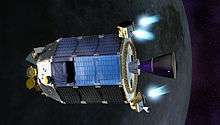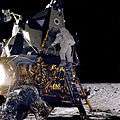Lunar Flashlight
 | |
| Mission type | Lunar orbiter |
|---|---|
| Operator | NASA |
| Website |
www |
| Spacecraft properties | |
| Spacecraft | Lunar Flashlight |
| Spacecraft type | CubeSat |
| Bus | 6U [1] |
| Manufacturer | JPL |
| Start of mission | |
| Launch date | November 2018 (planned)[1] |
| Rocket | SLS Block 1 |
| Launch site | Kennedy LC-39B |
| Orbital parameters | |
| Reference system | Polar |
| Periselene | 20 km (12 mi)[2] |
| Aposelene | 1000 to 5000 km[2] |
| Inclination | ≈90° (polar) |
| Moon orbiter | |
| Orbital insertion | January 2019 |
| Transponders | |
| Band | X band |
| Capacity | >10 kbps [3] |
The Lunar Flashlight is a planned low-cost CubeSat lunar orbiter mission to explore, locate, and estimate size and composition of water ice deposits on the Moon for future exploitation by robots or humans.[1][2][3][4][5][6]
The spacecraft, of the 6U CubeSat format, was developed by a team from the Jet Propulsion Laboratory (JPL), the University of California, Los Angeles (UCLA), and NASA Marshall Space Flight Center.[4] It was selected in early 2015 by NASA's Advanced Exploration Systems (AES) for a launch in November 2018.[1]
History
NASA's Lunar Crater Observation and Sensing Satellite (LCROSS), the Lunar Reconnaissance Orbiter (LRO) and India's Chandrayaan-1 lunar orbiters and other missions discovered in 2009 both water (H2O) and hydroxyl (—OH−) deposits at high latitudes on the lunar surface, indicating the presence of trace amounts of adsorbed or bound water are present.[2] These missions suggest that there might be enough ice water at polar regions to be used by future landed missions,[5][6] but the distribution is difficult to reconcile with thermal maps.[2]
Lunar prospecting missions are intended to pave the way toward incorporating use of space resources into mission architectures. NASA's planning for eventual human missions to Mars depends on tapping the local natural resources to make oxygen and propellant for launching the return ship back to Earth, and a lunar precursor mission is a convenient location to test such in situ resource utilization (ISRU) technology.[7]
The mission concept was developed by a team from the Jet Propulsion Laboratory (JPL), the University of California, Los Angeles (UCLA), and NASA Marshall Space Flight Center and proposed to NASA's FY2014 Advanced Exporation Systems (AES) call.[2][4] The mission was selected for funding in early 2015.[5][8]

In its original conception, the Lunar Flashlight spacecraft would have been a 6U CubeSat format or bus propelled by an 80 m2 solar sail that would also function as reflector to illuminate some selected permanently shadowed areas on the Moon,[5] while an onboard infrared spectrometer measured the reflected spectrum diagnostic of surface compositional mix among rock/dust, regolith, water ice, CO2, methane ice (CH4), and possibly ammonia ice (NH3).[2][3][5] The illuminated spot would have been about 400 m (1,300 ft) in diameter, reflected from an altitude of 20 km (12 mi).
Overview and objectives
The goal of Lunar Flashlight is to determine the presence or absence of exposed water ice and its physical state, and map its concentration at the 1-2 kilometer scale within the permanently shadowed regions of the lunar south pole.[4][9][10] The mission will be the first CubeSat to reach the Moon, and the first mission to use lasers to look for water ice.[1] Any polar volatile data collected by Lunar Flashlight could then ensure the most appropriate landing sites for a more expensive rover to perform in situ measurements and chemical analyses.[5] The spacecraft will maneuver to its lunar polar orbit and use its near infrared lasers to shine light into the shaded polar regions, while the on-board spectrometer measures surface reflection and composition.[1] Barbara Cohen from the NASA Marshall Space Flight Center is the Principal Investigator.[4]
Scientific payload
The proposed payload on this nanosatellite is an infrared spectrometer, consisting of a lens, dichroic beam splitters and multiple single-element detectors. It occupies 2 of the 6 modules of the 6U CubeSat bus.[2] The ADACS (attitude control), command and data handling, and power systems will occupy 1.5U; the Iris telecom system will occupy 0.5U.[3]
The Lunar Flashlight payload is derived from a few predecessor systems, including JPL's INSPIRE (INterplanetary NanoSpacecraft in a Relevant Environment), MARCO (Mars Cube One) and JPL's experience with spectrometers, including the Moon Mineralogy Mapper (M3).[1] The 6U CubeSat bus will utilize mostly commercial-off-the-shelf (COTS) components such as the lithium ion batteries, the CPU board, solar panels, star tracker and 3-axis reaction wheels for attitude control.[2] The CPU is a 'Rad-Tol Dependable Multiprocessor'.[3] JPL will provide the miniaturized INSPIRE suite that provides timing, navigation and telecommunication on the X-band,[2] which is to be monitored with the NASA Deep Space Network.[3]
Launch
The spacecraft will be launched as a secondary payload on the first test flight of the Space Launch System (Exploration Mission 1) scheduled for November 2018.[1]
Proposed trajectory
The Lunar Flashlight spacecraft will be ejected from the Space Launch System during its translunar flight, and will use a Sun sensor and solar panels to power the 3-axes reaction wheels. The concept is that it will then begin a trajectory toward a multiple lunar, and possibly an Earth swingby transfer; it will be captured into a lunar polar orbit in one or two months after launch depending on the selected trajectory.[2]
See also
References
- 1 2 3 4 5 6 7 8 "Lunar Flashlight Mission Information". JPL - NASA. April 2016. Retrieved 2016-04-23.
- 1 2 3 4 5 6 7 8 9 10 11 Cohen, Barbara A.; Sellar, R. G.; Staehle, R.; et al., eds. (2013). Lunar Flashlight: Mapping lunar surface volatiles using a CubeSat (PDF). Annual Meeting of the Lunar Exploration Analysis Group (2013). NASA - SSERVI.
- 1 2 3 4 5 6 Hayne, P. O.; Cohen, B. A.; B. T, B. T.; et al. (Mar 21, 2016). Lunar Flashlight: Illuminating the Moon's South Pole. 47th Lunar and Planetary Science Conference.
- 1 2 3 4 5 "NASA TechPort: Lunar Flashlight Project". NASA TechPort. National Aeronautics and Space Administration. Retrieved 19 November 2015.
- 1 2 3 4 5 6 7 "Lunar Flashlight". Solar System Exploration Research Virtual Institute. NASA. 2015. Retrieved 2015-05-23.
- 1 2 Wall, Mike (9 October 2014). "NASA Is Studying How to Mine the Moon for Water". Space.com. Retrieved 2015-05-23.
- ↑ "NASA Looking to Mine Water on the Moon and Mars". Solar System Exploration Research Virtual Institute. NASA. 2015. Retrieved 2015-05-23.
- ↑ Misra, Ria (2 February 2016). "NASA's New Mission to Mars Will Include a Giant Laser 'Lunar Flashlight'". Gizmodo. Retrieved 2016-04-23.
- ↑ LUNAR FLASHLIGHT: MAPPING LUNAR SURFACE VOLATILES USING A CUBESAT. (PDF) Annual Meeting of the Lunar Exploration Analysis Group (2014).
- ↑ Cohen, B. (25 January 2016). "CubeSat for investigating ice on the Moon". SPIE Newsroom. doi:10.1117/2.1201601.006241.

